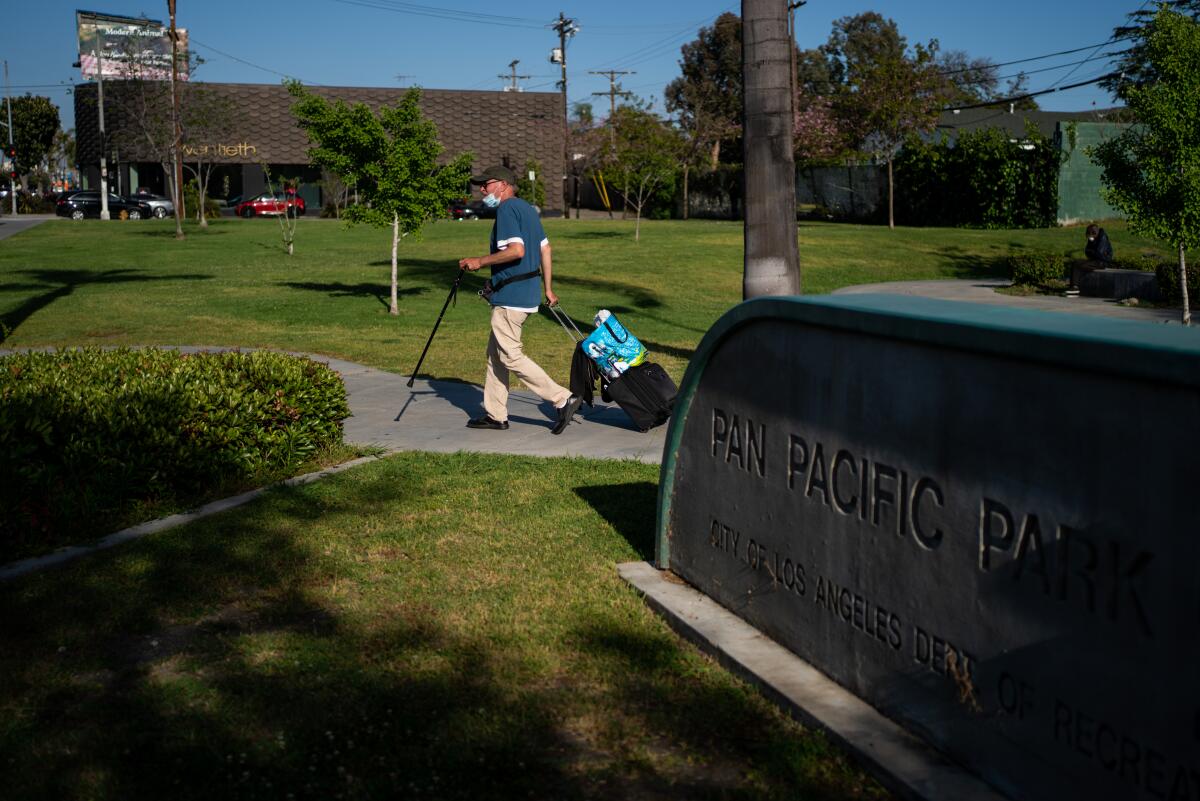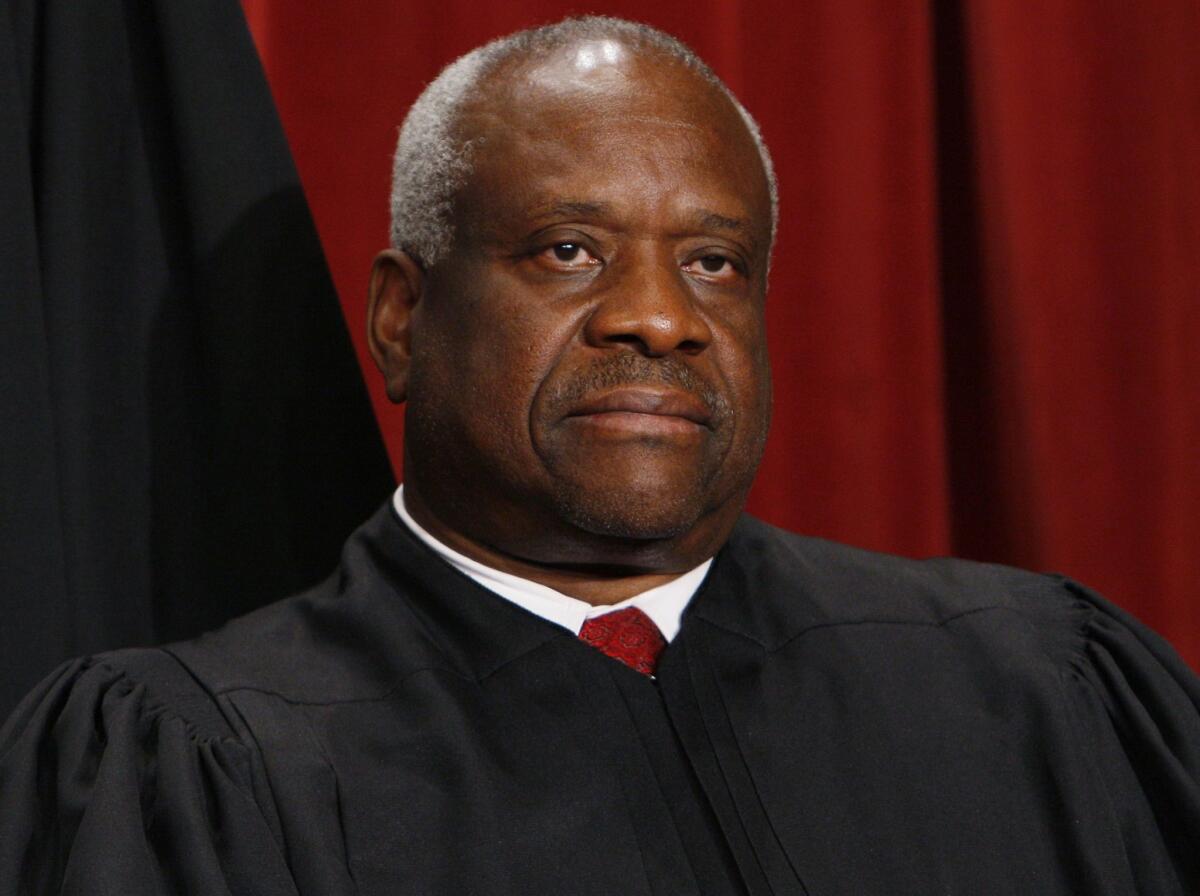Newsletter: A bid to protect the vulnerable starts slowly

Good morning, and welcome to the Essential California newsletter. It’s Wednesday, May 20, and I’m writing from Los Angeles.
Sign up for Essential California
The most important California stories and recommendations in your inbox every morning.
You may occasionally receive promotional content from the Los Angeles Times.
There were many possible catastrophes on the horizon as the coronavirus terror first seized California and officials raced to prepare for worst-case scenarios. But one potential tinderbox loomed particularly large — what would happen when new emergency collided with old, and a novel virus met the state’s long-unfolding homelessness crisis?
Stay-at-home orders work only if you have a home to stay in. In a state where 151,000 people sleep on street corners, under bridges and in emergency shelters, homeless encampments presented significant vulnerabilities for containing the spread of disease. Early state modeling from before California began to flatten the curve showed that 60,000 homeless people could be hit by the novel coronavirus, with up to 20% of them needing hospitalization, potentially devastating an already-strained healthcare system.
[Previously: “Coronavirus hitting California’s homeless population could be what finally breaks hospitals” on March 18 in the Los Angeles Times]
What happened next, like many other actions propelled into motion by the coronavirus, was unprecedented. In early April, Gov. Gavin Newsom launched a coordinated effort to address homelessness during the pandemic. Project Roomkey aimed to secure 15,000 hotel and motel rooms throughout California so that homeless people could protect themselves from conditions such as those on the street and in crowded homeless shelters. The program is largely funded by the Federal Emergency Management Agency and administered on the county level.
Only homeless people who meet certain criteria, including being older than 65 and having health conditions that make them susceptible to dying of COVID-19, qualify. The goal of leasing 15,000 rooms would fall far short of reaching the total number of unhoused Californians in those vulnerable groups, but it still represented a massive undertaking that would have to unfold on a far more rapid timeline than most housing programs.
Now, more than a month into the program, a review of state records shows that only about half of the 15,000 hotel and motel rooms that California has leased for mostly homeless people to slow the spread of the coronavirus are occupied.
[Read the story: “California leased 15,000 hotel rooms to help homeless people. Half now sit empty” in the Los Angeles Times]
My colleagues Ben Oreskes and Doug Smith, who cover homelessness for The Times, found that the program has thus far “led to mixed results.” In general, “it has progressed so slowly that it has fallen short of many expectations and is unlikely to get most of those who need help indoors.”
As of Monday, 7,919 hotel rooms had guests, and another 7,700 were vacant, according to figures released by Newsom’s office. The actual number of rooms leased for homeless people under Project Roomkey could be even lower, since Newsom’s goal also included rooms reserved for people, homeless or not, who needed to quarantine or isolate themselves because of the coronavirus.
According to Doug and Ben’s story, the largest impediments in some counties have been delays in preparing leased rooms for occupancy — not, as the governor has complained, NIMBY interests at the local level. In other counties, a shortage of staff to care for homeless residents, providing services such as food services, security, nursing and case management, have been responsible for delays.
Los Angeles County has set its own goal of getting 15,000 people — a quarter of the county’s homeless population — into hotel rooms. As of now, officials have leased 3,337 hotel rooms across the county. Of those, 2,149 are occupied, 735 are ready for someone to move in, and 453 still need to be prepared.
[See also: “Track L.A.’s effort to house thousands of homeless people during coronavirus” in the Los Angeles Times]
And now, here’s what’s happening across California:
Los Angeles County officials’ newest goal is to further reopen the economy by July 4, officials said Tuesday. The mission is to safely reopen retail businesses, restaurants and malls. But getting there will be slow going. Los Angeles Times
The U.S. Justice Department is warning California that coronavirus rules may violate religious freedoms: The department issued a letter Tuesday warning that the state could be violating religious freedoms in its plan to reopen after the coronavirus stay-at-home order. Los Angeles Times
L.A. STORIES
Nearly 5% of L.A. County residents might have already had coronavirus: A study suggests that substantially more people have been infected by the coronavirus than what the county’s confirmed case count shows, backing previous findings from preliminary serology findings reported last month. Los Angeles Times
Pet grooming services and car washes can reopen in L.A. Customers can drop off and pick up their pets outside the store, but like at other retail shops, only employees will be allowed to enter the building, Mayor Eric Garcetti said. Los Angeles Times
Support our journalism
IMMIGRATION AND THE BORDER
Undocumented workers flooded California’s coronavirus disaster relief website Monday, causing the site to crash for several hours. Monday was the first day undocumented Californians could apply for the one-time payment of $500 per individual or $1,000 per household. Fresno Bee
POLITICS AND GOVERNMENT
President Trump threatened to withdraw altogether from the World Health Organization, a move that would leave Chinese leader Xi Jinping as the most prominent voice leading the global fight against the pandemic. Bloomberg
CRIME AND COURTS
After 28 years of rarely speaking from the bench, Justice Clarence Thomas is newly in the public eye as he regularly asks questions during the conference call Supreme Court oral arguments being broadcast live during the pandemic. New York Times

HEALTH AND THE ENVIRONMENT
The University of California announced that it has fully divested from all fossil fuels, becoming the nation’s largest educational institution to do so as campaigns to fight climate change through investment strategies proliferate at campuses across the country. Los Angeles Times
CALIFORNIA CULTURE
Orange County hopes to open malls, restaurants and other retail soon. The day after Gov. Gavin Newsom cracked the door for more counties to potentially lift additional coronavirus-related restrictions, Orange County officials made it clear that they want to get through as quickly as possible. Los Angeles Times
The hot new thing in clubby Silicon Valley? An invite-only (so far) social network called Clubhouse. New York Times
Opening day has been set for long-awaited BART stations in Milpitas and San Jose. For the first time in BART’s 48-year history, riders will be able to take its trains across the Santa Clara County line, beginning next month. East Bay Times
Bakersfield’s home market outperforms the rest of the state during the pandemic: The city’s median home sale price rose 3.8% in April to $274,000, while California overall experienced a 1% dip. Bakersfield Californian
What’s the future for California salons and barbershops? Hairstylists worry and wait. Los Angeles Times
NOT EVERYTHING IS TERRIBLE
A doe and her fawns, bluebirds and a turtle: North Bay residents share wildlife viewings from their neighborhood walks. Santa Rosa Press-Democrat
“The idea behind the group is that it’s not charity, but solidarity.” In the mountain community of Idyllwild, neighbors take care of each other through a mutual aid group. Idyllwild Town Crier
A poem to start your Wednesday: “It’s a Living” by Richard Vargas. TheWriter’s Almanac
CALIFORNIA ALMANAC
Los Angeles: sunny, 75. San Diego: sunny, 73. San Francisco: partly sunny, 64. San Jose: partly sunny, 73. Fresno: sunny, 78. Sacramento: sunny, 78. More weather is here.
AND FINALLY
Today’s California memory comes from Karina Moreno:
Nothing ties NorCal and SoCal together like the I-5 freeway. In Berkeley, Papi would haul my siblings and me out of bed at 3 a.m., line us up still sleeping in the back of a two-toned Suburban for the drive to San Diego. If we were lucky, we didn’t wake up to cow dung stench at Harris Ranch, but made it all the way to Grapevine, where bursts of orange and yellow wildflowers greeted us in late spring. If timed right, we dodged L.A. traffic, and when we saw the bosom of the San Onofre nuclear plant, we knew we were within reach of our cousins.
If you have a memory or story about the Golden State, share it with us. (Please keep your story to 100 words.)
Please let us know what we can do to make this newsletter more useful to you. Send comments, complaints, ideas and unrelated book recommendations to Julia Wick. Follow her on Twitter @Sherlyholmes.
Sign up for Essential California
The most important California stories and recommendations in your inbox every morning.
You may occasionally receive promotional content from the Los Angeles Times.




